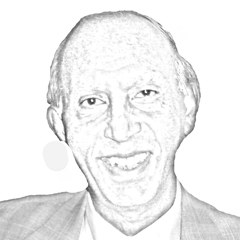We have a discussion-cum-social group in Stockholm that has been meeting regularly every month since 1991. It comprises almost entirely Punjabis, mostly from Lahore but other places as well and from East Punjab. Last time we met, an excellent paper was read by Ajmal Butt on Sufism in which he assessed its overall political and social impact on society. He was of the opinion that although Sufism advocated love and friendship, and thus appealed to broad sections of society, in the historical process it was co-opted by Muslim rulers as part of the state project and thus became an extension of the status quo. He was also of the opinion that Sufi influence had muted resistance to oppression by preaching withdrawal from worldly affairs.
Some of us took the view that Sufism needs to be distinguished from piri-faqiri, even though both emanate from the same mystical roots. Ideally, a Sufi represents anti-conformism but pirs may not. Over time, the shrines of Sufi masters can be exploited by their descendants or custodians for mundane purposes such as receiving money and other gifts from the gullible masses who visit them in search of miracles and so on.
However, historically pristine Sufism’s pantheistic thrust furnished avenues for stepping out of the box of dogmatism and embracing unconventional ideas. Shah Hussain, Shah Inayat Qadri Lahori, Bulleh Shah, Khawaja Ghulam Farid, Mian Muhammad Bakhsh and many other great names can be considered as the representatives of the rebel tradition of Sufism.
Most interestingly, Sufism, as a tradition of resistance to the status quo and inclusion in an egalitarian brotherhood, has evolved in the contemporary Indian East Punjab into a great movement of Dalit assertion. Inspiration from the teachings of Guru Ravidas (a 15th-16th century Dalit), Bhagat Kabir, Guru Nanak and many others has synthesised with East Punjab’s Sufi revival and created syncretic movements.
This fact dawned upon me in a most powerful manner when I saw documentaries on this subject by an exceptionally talented and enlightened filmmaker, Ajay Bhardwaj (a Brahmin). His remarkable contribution comprises a trilogy: Kitte Mil Ve Mahi (where the twain shall meet); Rabba Hun Kee Kariye (thus departed our neighbours), and Milange Babey Ratan De Mele Te (We shall meet at the festival of Baba Ratan).
Bhardwaj is a socially aware and committed progressive who contextualises Kitte Mil Ve Mahi (2005) in the grim social reality of contemporary East Punjab society. He interviews the legendary Baba Bhagat Singh Bilga of the Ghadar Party in Jullundur. I have had the privilege of meeting Babajee in his son’s home in northern England some 20 years ago. My friend Mahfooz Ahmad drove me all the way from London to meet him. He reminded me of a generation of old revolutionaries who till their last days remained steadfast in their commitment to the uplift of the oppressed and downtrodden.
Now, the dominant group in East Punjab is that of Sikh Jatts. They are the main landowners, mostly independent peasant-proprietors. In East Punjab and the adjacent Haryana state, the maximum agricultural landholding is 7-21 hectares (17-50 acres), depending on access to irrigation and whether crops are grown or it is a fruit orchard. Despite Sikhism’s egalitarianism, caste prejudices are salient among its followers. The Jatts look down upon the Dalits. As a result Dalit Sikhs, also known as Mazhabi Sikhs, often go to separate gurudwaras.
Baba Bhagat Singh Bilga (himself a Jatt) tells Bhardwaj that the policy of reservation for the scheduled castes (Dalits) and scheduled tribes (indigenous people) mandated by the Indian Constitution has enabled those oppressed groups to achieve social mobility and now a Dalit intelligentsia is asserting its separate identity in opposition to the Jatt Sikhs and upper caste Hindus. As a true revolutionary and humanist Babajee says the Dalit assertive movement should be welcomed and they should be made to feel equal to others so that they become part of a progressive India.
Bhardwaj interviews a Dalit poet and revolutionary, Lal Singh Dil, who recites some poems about the historical and contemporary injustices to his community. Dil can be seen as having converted to Islam and praying according to Muslim rites. He speaks of the Dalit attraction to the Naxalite movement and supports it as a means to resist caste oppression. On the other hand, he laments that Dalits who through reservation become government officials, try to hide their identity to escape social stigma.
In any case, through the teachings of Ravi Das, the Dalits connect to the Qadri and Chishtia Sufi Orders. Dalit Sufis can be both men and women, which is a fascinating innovation. These men and women bear Hindu names but are buried in graves painted in green and in the case of their leading saints, the tombs are covered with a green cloth. They proclaim themselves as disciples of Ghaus-ul-Azam, Khawaja Moinuddin Chishti, Baba Farid Shakarganj and other famous Sufis. We hear qawwals bearing Hindu names singing classic devotional poetry in praise of the Muslim saints and, indeed, Hazrat Ali and the Prophet (PBUH). Thus, the syncretism that I identified as a very robust feature of pre-partition Punjab continues to thrive in East Punjab.
Dalit Sufi saints named in the documentary bear the title Shah at the end of their name. Thus, Doshinde Shah, Najjar Shah and so on are Dalits who bear the honorific title of Shah to express their saintliness. It is a fascinating subject that Bhardwaj captures with great sensitivity in Kitte Mil Ve Mahi.
(To be continued)
The writer has a PhD from Stockholm University. He is a Professor Emeritus of Political Science, Stockholm University. He is also Honorary Senior Fellow of the Institute of South Asian Studies, National University of Singapore. His latest publication is The Punjab Bloodied, Partitioned and Cleansed: Unravelling the 1947 Tragedy through Secret British Reports and First-Person Accounts (Karachi: Oxford University Press, 2012; New Delhi: Rupa Books, 2011). He can be reached at billumian@gmail.com
